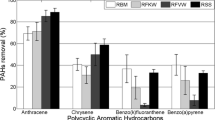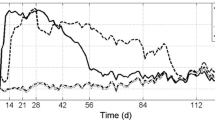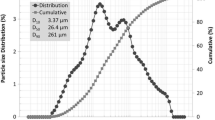Abstract
The contaminated Kaynaklar soil containing high level of diesel (100,000 mg/kg dw) was treated in slurry systems with solid-to-liquid ratios (S/L) of 1/5, 1/10, and 1/20 to describe the performance of physical treatment. The soil microbial mass was inhibited by using mercury chloride and autoclaving prior to the diesel spiking in order to eliminate any bacterial degradation of non-aqueous phase liquids (NAPLs) and has been treated in the reactor systems for 8 h. The removal performance of PAHs in soil slurry systems was evaluated according to the number of benzene rings: 3, 4, and 5and 6 ring PAHs. The experimental results showed that PAH treatment efficiency sharply decreases in slurry soils with increasing number of benzene rings; maximum treatment efficiencies in soil were 82%, 56%, and 42% for 3 ring (ACY), 4 ring (PY), and 5 and 6 ring (BbF) PAHs, respectively. In addition, a significant correlation between the PAH removal efficiencies and their vapor pressures has found. The impact of solid-to-liquid ratio on slurry system performance was found negligible; therefore, higher solid-to-liquid ratios are recommendable to be applied on the contaminated sites to remove high concentrations of PAHs from soil for reducing the investment and operational costs. The soil used in this study has relatively large specific surface area and considerable amount of clay. The removal performance of slurry systems may be elevated with sandy soils containing high concentrations of PAHs, where can be faced at the seashores due to the off shore oil spills.






Similar content being viewed by others
References
Akıncı, G., & Guven, E. D. (2011). Bioleaching of heavy metals contaminated sediment by pure and mixed cultures of Acidithiobacillus Spp. Desalination., 268, 221–226.
Antizar-Ladislao, B., Lopez-Real, B., & A. J. (2006). Degradation of polycyclic aromatic hydrocarbons (PAHs) in an aged coal tar contaminated soil under in-vessel composting conditions. Environmental Pollution, 141, 459–468.
APHA-AWWA-WEF. (2005). Standard methods for the examination of water and wastewater (21st ed.). Washington, DC: American Public Health Association/American Water Works Association/Water Environment Federation.
Arabi, M., Sadeghi, M., & Anyakora, C. (2009). Phenanthrene contaminated soil biotreatment using slurry phase bioreactor. American Journal of Environmental Sciences, 5(3), 223–229.
ATSDR -Agency for Toxic Substances and Disease Registry. (1995). Toxicological profile for polycyclic aromatic hydrocarbons (PAHs) (p. 458). Atlanta: Publication of U.S. Department of Health & Human Services.
Balachandran, C., Duraipandiyan, V., Balakrishna, K., & Ignacimuthu, S. (2012). Petroleum and polycylic aromatic hydrocarbons (PAHs) degradation and naphthalene metabolism in Streptomyces sp. (ERI-CPDA-1) isolated from oil contaminated soil. Bioresource Technology, 112, 83–90.
Çelebi, H., Gök, O., & Sponza, D. T. (2016). Removals of non-analogous OTC and BaP in AMCBR with and without primary substrate. Environmental Technology, 37(14), 1768–1781. https://doi.org/10.1080/09593330.2015.1131752.
Celin, S. M., Sahai, S., Kalsi, A., & Bhanot, P. (2019). Environmental monitoring approaches used during bioremediation of soils contaminated with hazardous explosive chemicals. Trends in Environmental Analytical Chemistry. https://doi.org/10.1016/j.teac.2020.e00088.
Cerniglia, C. E., & Heitkamp, M. A. (1991). Microbial degradation of polycyclic aromatic hydrocarbons in the aquatic environment. In U. Varanasi (Ed.), Metabolism of polycyclic aromatic hydrocarbons in the aquatic environment (pp. 41–341). Boca raton: CRC Press.
Chen, S. Y., & Lin, J. (2000). Influence of solid content on bioleaching of heavy metals from contaminated sediment by Thiobacillus spp. Journal of Chemical Technology and Biotechnology, 75, 649–656.
De Luca, G. D., Furesi, A., Micera, G., Panzanelli, A., Piu, P. C., Pilo, M. I., et al. (2005). Nature, distribution and origin of polycyclic aromatic hydrocarbons (PAHs) in the sediments of Olbia harbor (northern Sardinia, Italy). Marine Pollution Bulletin, 50, 1223–1232.
Erdik, M. (2007) Report on 1999 Kocaeli and Düzce (Turkey) earthquakes, retrieved in October 2011, from http://www.koeri.boun.edu.trdepremmuh/eqspecials/kocaeli/kocaelireport.pdf, retrieved at 01.11.2015.
Feizi, R., Jorfi, S., & Takdastan, A. (2020). Bioremediation of phenanthrene-polluted soil using Bacillus kochii AHV-KH14 as a halo-tolerant strain isolated from compost. Environmental Health Engineering and Management Journal, 7(1), 23–30.
Forján, R., Lores, I., Sierra, C., Baragaño, D., Gallego, J. L. R., & Peláez, A. I. (2020). Bioaugmentation treatment of a PAH-polluted soil in a slurry bioreactor. Applied Sciences, 10, 2837. https://doi.org/10.3390/app10082837.
Gök, G. (2012). The factors effecting the remediation of non-aqueous phase liquid (NAPLS) contaminants in soils. Graduate School of Natural and Applied Sciences of Dokuz Eylül University, Ph.D. Thesis.
Gök, G., & Gürbüz, O. A. (2020). Application of geostatistics for grid and random sampling schemes for a grassland in Nigde, Turkey. Environmental Monitoring and Assessment, 192(5), 300. https://doi.org/10.1007/s10661-020-08281-7.
Gok, O., & Sponza, D. T. (2011). Effects of sludge retention time (SRTs) on the removals of polycyclic aromatic hydrocarbons (PAHs), chemical oxygen demand (COD), and toxicity in a petrochemical industry wastewater. Journal Desalination and Water Treatment, 26(1–3), 57–65.
Gondek, K., & Filipek-Mazur, B. (2005). The effects of mineral treatment and the amendments by organic and organomineral fertilisers on the crop yield, plant nutrient status and soil properties. Plant, Soil and Environment, 51(1), 34–45.
Güven, D., & Akıncı, G. (2009). İzmir körfez sedimentlerinde ağır metal çözünürlüğünün katı/sıvı oranına bağlı değişimi. Çevre Bilim ve Teknoloji, Teknik Dergi, 3(2), 37–46.
Kanaly, R. A., & Harayama, S. (2000). Biodegradation of high - molecular weight polycyclic aromatic hydrocarbons by bacteria. Journal of Bacteriology, 182, 2059–2067.
Lasota, J., & Błońska, E. (2018). Polycyclic aromatic hydrocarbons content in contaminated forest soils with different humus types. Water, Air, & Soil Pollution, 229, 204.
Li, Y., Liao, X., Huling, S. G., Xue, T., Liu, Q., Cao, H., & Lin, Q. (2019). The combined effects of surfactant solubilization and chemical oxidation on the removal of polycyclic aromatic hydrocarbon from soil. Science of the Total Environment, 647, 1106–1112.
Liu, S., Xia, X., Yang, L., Shen, M., & Liu, R. (2010). Polycylic aromatic hydrocarbons in urban soils of different land uses in Beijing, China: Distribution, sources and their correlation with the city’s urbanization history. Journal of Hazardous Materials, 177, 1085–1092.
Lukić, B., Panico, A., Huguenot, D., Fabbricino, M., van Hullebusch, E. D., & Esposito, G. (2016). Evaluation of PAH removal efficiency in an artificial soil amended with different types of organic wastes. Euro-Mediterr J Environ Integr, 1, 5.
Lumia, L., Rabbenia, G., Giustraa, M. G., Giumentoa, S., Gallob, G., & Bellaa, G. D. (2020). Treatment of contaminated sediments by bio-slurry reactors: Study on the effect of erythromycin antibiotic. Chemical Engineering Transactions, 79, 391–396. https://doi.org/10.3303/CET2079066.
Lundstedt, S., White, P. A., Lemieux, C. L., Lynes, K. D., Lambert, I. B., Öberg, L., Haglund, P., & Tysklind, M. (2007). Sources, fate, and toxic hazards of oxygenated polycyclic aromatic hydrocarbons (PAHs) at PAH- contaminated sites. Ambio: A Journal of the Human Environment, 36(6), 475–485.
Mahanty, B., Pakshirajan, K., & Venkata Dasu, V. (2008). Biodegradation of pyrene by Mycobacterium frederiksbergense in a two-phase partitioning bioreactor system. Bioresource Technology, 99(7), 2694–2698.
Ossai, I. C., Ahmed, A., Hassan, A., & Hamid, F. S. (2020). Remediation of soil and water contaminated with petroleum hydrocarbon: A review. Environmental Technology & Innovation, 17, 100526.
Piskonen, R., & Itavaara, M. (2004). Evaluation of chemical pretreatment of contaminated soil by improved PAH bioremediation. Applied Microbial Biotechnology, 65, 627–634.
Poluszyńska, J., Jarosz-Krzemińska, E., & Helios-Rybicka, E. (2017). Studying the effects of two various methods of composting on the degradation levels of polycyclic aromatic hydrocarbons (PAHs) in sewage sludge. Water, Air, & Soil Pollution, 228, 305.
Saponaro, S., Bonomo, L., Petruzzelli, G., Romele, L., & Barbafieri, M. (2002). Polycyclic aromatic hydrocarbons (PAHs) slurry phase bioremediation of a manufacturing gas plant (MGP) site aged soil. Water, Air, & Soil Pollution, 135, 219–236.
USEPA (United States Environmental Protection Agency). Method 9045 C: Soil and Waste pH. Revision 3. USEPA (United States Environmental Protection Agency), 1998. EPA's Contaminated Sediment Management Strategy, 823- R-98-001. 1995.
Vijayan, A., Österlund, H., Marsalek, J., & Viklander, M. (2019). Laboratory melting of late-winter urban snow samples:The magnitude and dynamics of releases of heavy metals and PAHs. Water, Air, & Soil Pollution, 230, 182.
Author information
Authors and Affiliations
Corresponding author
Ethics declarations
Conflict of Interest
The authors declare that they have no conflict of interest.
Additional information
Publisher’s Note
Springer Nature remains neutral with regard to jurisdictional claims in published maps and institutional affiliations.
Rights and permissions
About this article
Cite this article
Gök, G., Akıncı, G. The Performance of Slurry Phase Reactors on the Treatment of Polycyclic Aromatic Hydrocarbons from Soils. Water Air Soil Pollut 231, 368 (2020). https://doi.org/10.1007/s11270-020-04729-1
Received:
Accepted:
Published:
DOI: https://doi.org/10.1007/s11270-020-04729-1




